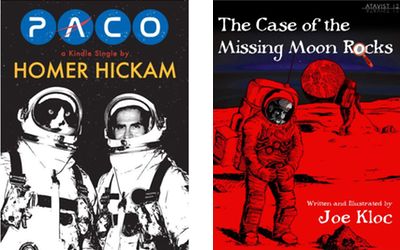Reviews: short space ebooksby Jeff Foust
|
| These books demonstrate that the advance of ebooks opens up a wide range of storytelling possibilities, including on space topics, that previously weren’t feasible in print. |
And what of the titular cat, Paco? Hickam recounts how he adopted the cat shortly after moving into a new home in Huntsville, and how Paco became a favorite of astronauts and others who visited. The latter portion of the book describes how Paco came to meow in space: the cat itself stayed on the ground, but his recorded meows, transmitted to the shuttle during one of those Spacelab missions, helped cheer up an astronaut suffering from a case of spacesickness severe enough to jeopardize the mission’s research. (Hickam doesn’t name the astronaut in question, calling her only “Jamie”, but provides enough clues that anyone familiar with the Spacelab missions and their crews would be able to identify her.)
While Paco: The Cat Who Meowed in Space is something of a short memoir, The Case of the Missing Moon Rocks is instead an extended version of a magazine article. Joe Kloc describes the efforts of Joseph Gutheinz to track down lunar rocks from the Apollo program that made their way onto the black market. The US government, as a goodwill gesture, provided small lunar samples to various countries, and also made similar gifts to the states as well. Over time, though, some of these samples were lost or stolen. The book starts with an investigation by Gutheinz, then working for NASA’s Office of the Inspector General, into a lunar rock for sale that had originally been given to Honduras.
That interest in finding those missing lunar samples continued after Gutheinz left NASA, as he enlisted students in an online class he taught at the University of Phoenix to track down those lunar gifts that were unaccounted for. Some were simply misplaced, like one given to Canada that sat in storage in a museum for decades, while others were lost, like Alaska’s in a museum fire, only to resurface decades later. There’s still plenty of work to do: 160 of the 377 Moon rocks given out by Presidents Nixon and Ford were still unaccounted for as of the book’s publication earlier this year.
Both books are interesting reads that are sized to the subject matter, although Hickam’s book arguably could have been longer given the number of asides in the text about how a particular tale was a story for another time. Both are quick reads, as you might expect given their size, polished off on a cross-country plane flight with hours to spare. (The page counts above are provided by Amazon as its estimate of their length if printed, an approximate measure at best given that “page” is a meaningless metric when the reader has control over font size and thus how much text appears on a screen at once.) They demonstrate that the advance of ebooks opens up a wide range of storytelling possibilities, including on space topics, that previously weren’t feasible in print.
